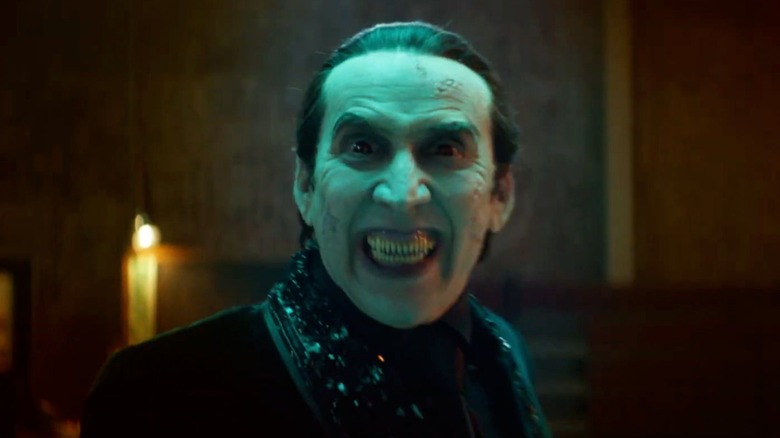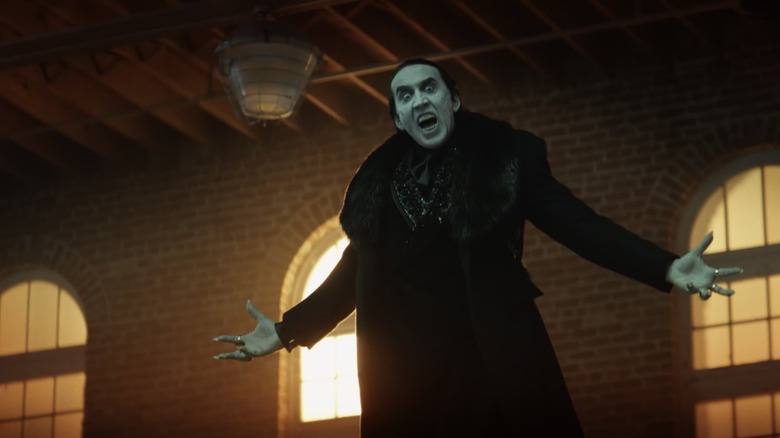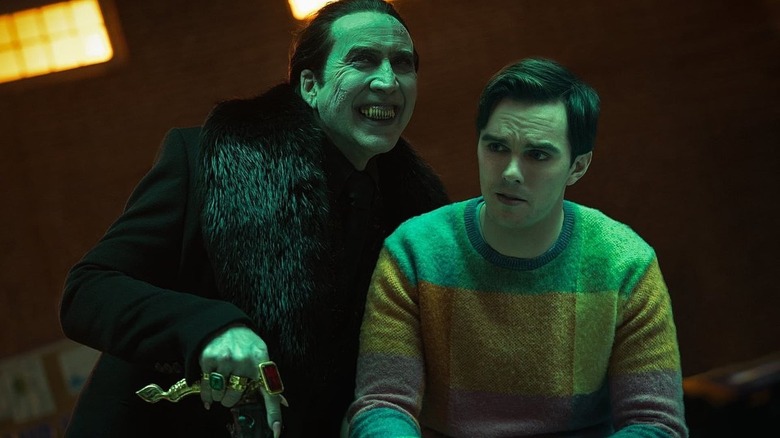Nicolas Cage Didn't Go Method For Renfield's Dracula, Despite Chris McKay's Claims
A lot is misunderstood about the Method.
Methos acting, originally called the Stanislavski System, was pioneered by Konstantin Stanislavski in his 1936 book "An Actor Prepares." In brief — and it's far more involved than this — the Method involved an acting that was based on the experienced emotions of the actor rather than mere representation. It is a Method actor's job to seek through their own psyche to find a similar motivational impulse as their character, and draw from it to create all the smaller, subconscious movements that a person would authentically display in that moment. A Method actor would constantly be asking themselves how they would personally react under a play's given circumstances.
Method approaches have famously brought some actors to undue extremes. One might have heard the story of Dustin Hoffman who, to match the fatigue of his character in "The Marathon Man," elected to actually stay up all not and actually be fatigued. His co-star, Laurence Olivier, famously said, "Try acting. It's so much easier."
There is nothing in any writings on the Method, however, about actors needing to remain in character off-screen or off-stage. Famed acting teacher Lee Strasberg himself even wrote an essay debunking this myth. When modern journalism refers to "going full Method," they usually refer to actors who have elected — by their own choice, and not by the dictates of Method acting — to stay in character 24/7.
In a Daily Mail article published in March, "Renfield" director Chris McKay claimed that his Dracula, Nicolas Cage, "went full Method," staying in character during the film's entire shoot. A few days later, Cage spoke to the Daily Mailas well, and said that, no, he did not "go full Method." He dropped character when the cameras stopped rolling.
Nouveau Shamanism
Cage had repeatedly gone on record, describing his acting style as "nouveau shamanism." In interviews, Cage has said that he derived his style — or at least thought to define it — after what he read in a pair of books written by psychologist Brian Bates. In "The Way of Wyrd," a medieval monk treks outside of the cities to convert the "heathens," only to learn their shamanistic ways. Bates' 1988 book, "The Way of the Actor," posited that actors were modern shamans, as they communicate a contemporary version of "intuitive wisdom," channeling fictional beings through themselves.
This is all, by Cage's own admission, a little highfalutin, but "nouveau shamanism" is a cool-sounding term that he prefers. It's also, one might immediately see, quite far from Stanislavski's actual Method, as well as the common misconception of the Method.
Previously, in reference to Cage playing Dracula, Chris McKay was quoted as saying:
"Whatever scene we did he would still be 100% living in that attitude after we stopped shooting. [...] So if he's a little frosty in the scene he's going to have a little bit of that between takes. But still up for whatever we were doing."
Cage, however, chimed in to rebut during a red carpet interview before "Renfield," saying:
"I just don't have that recollection, I don't know why Chris said that. [...] I had a lot of laughs in between takes with both Chris McKay and Nick Hoult, so maybe that was his experience, maybe because I still had the fangs in my mouth that made me speak a certain way, but that wasn't my experience."
Being creepy and fun
Indeed, if one is speaking with fangs, a certain voice would have to be maintained by necessity. But that's not the same thing as staying in character.
In Cage's brief interview, he also said that Count Dracula, one of the most popular characters in cinema history, needs to be played a certain way and that it involves nailing a certain balance for the audience. In thinking about the audience's perception of him, Cage revealed quite starkly that he is no student of the Method. He told THR, "With this Dracula, I was trying to fuse that which is scary and humorous even at the same time in the line delivery. [...] It was just how can you be creepy and funny at the same time, that was the challenge."
Cage, like all of us, had to consider some of cinema's most famous Dracula actors when inventing his own version of the character. Bela Lugosi, to this day, is still the standard by which we measure all Draculas. Christopher Lee also made a notable impression playing Dracula in a long series of movies for Hammer Studios in the '50s through the '70s. Less celebrated but still incredible is Frank Langella's version of Dracula from the 1979 film, and Cage even looked to Gary Oldman, who played Dracula in the gothic horror opera "Bram Stoker's Dracula," directed by his uncle. Overall, however, he took a lot of mannerisms, he said, from his father, August. In his words:
"He always spoke with distinction, he was always very elegant and eloquent, he was always the smartest man in every room he walked in and he knew, and he made sure we knew. I think Dracula, being around for so many years, would have some of that aura."
"Renfield" hits theaters on April 14.


